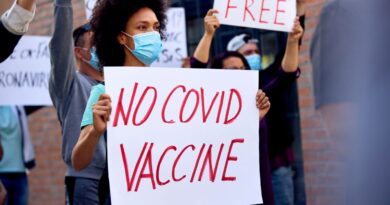French National Academy of Medicine: COVID Nasal Swabs Associated with Increased Meningitis Risk

The Académie nationale de médecine, an independent but official learned society in France, published a statement on Thursday warning that nasopharyngeal swabs used for PCR tests to detect the SARS-CoV-2 virus “are not without risks.” The alert came days before nasal auto-testing kits will become available in French pharmacies.
According to the statement published online by the Academy, a growing amount of data show that “complications” can and do occur, some of them “serious.”
Most are “benign,” and include “discomfort, pain or bleeding.” But the statement notes that over the last weeks, scientific articles have been appearing in medical journals describing undesirable events “including breaches of the anterior skull base associated with a risk of meningitis.”
Several studies were quoted by the Academy, including one documenting “meningitis due to cerebrospinal fluid leak after nasal swab testing for COVID-19.”
The nasopharyngeal swab is done with a long, thin cotton swab introduced high up into the nasal cavity, often successively via both nostrils, and rotated quickly each time in order to collect a sample of cells and mucus to analyze for the Wuhan virus using the highly controversial PCR test, or to be used in view of an antigenic test.
The Academy noted that these tests have now become extremely common. The learned society is concerned because swabs are being increasingly used, and that more and more individuals are getting repeat tests, “sometimes in inadequate conditions.”
“It is important to recall that precautions need to be taken and that risks do exist,” it said.
The Academy advises that medical personnel should be making the swabs, and then exclusively those who received training to be able to observe the necessary “technical conditions.”
These include asking patients whether they had a medical history of accidents or surgery in the ORL field that may have modified the anatomy of the nasal and sinus cavities, and not placing their heads in hyperextension during sample taking: they should remain in a natural position, with the chin “parallel” to the floor. Swabs should be introduced “horizontally following the base of the nasal cavity and they should under no circumstance be deviated upwards, in the direction of the base of the skull.”
The Académie de médecine appears to be particularly worried about children, strongly suggesting that they should be tested using saliva samples “because of both their safety and their acceptability.”
Regarding the upcoming auto-tests that also rely on nasal swabs, the statement said that their users should be warned about their use. “Auto-sampling can lead to false negatives when the swab is too shy and too superficial, but it can also become dangerous when the swab goes too deep and is orientated in the wrong direction,” it said.
Auto-tests are not exactly like the nasal swabs used by health professionals in France since the beginning of the COVID crisis: the swab is shorter, wider, and less disagreeable and only requires entering three to four centimeters into the nasal cavity – some of these swabs, but not all, include a little “collar” showing how far to go. Instead of being processed in special lab instruments, the auto-test will give a positive or negative result within minutes. If negative, people are advised to continue “social distancing” and wearing masks; if positive, the result needs to be confirmed by an RT-PCR test in order to mark the “variant” and allow contact-tracing.
French health authorities are hoping that the tests will be used by private individuals who want to know their status before a visit to a vulnerable person, for instance, but they also expect to use them for large-scale testing in apartment buildings or high schools for people aged over 15.
In Germany, similar tests are being marketed and will include a flash code allowing the identification and tracking of “positive cases.”
At the beginning of the crisis in March 2020, very little testing was done even on symptomatic patients, to the detriment of isolation procedures that would have stopped the spread of the virus much more efficiently. If early treatment of positive patients had been allowed and recommended, many would not have seen their condition worsen: according to Professor Christian Perronne, 24,500 deaths out of 30,000 during the spring epidemic last year could have been avoided.
Now testing in France is beyond imagination. Since March 1, 2020 and April 4 of this year, some 70 million tests were done: 57.7 million PCR tests, the rest antigenic, according to a public health statistics institution, DREES. And the numbers are going up and up: from March 29 to April 4, 3.8 million test results were validated in one week. They were obviously not limited to people with flu-like symptoms.
PCR tests remain the so-called gold standard of COVID-19 testing, even though the World Health Organization (WHO) has warned that they should mostly be considered as an “aid for diagnosis” and that their results should be carefully interpreted according to manufacturers’ guidance and accompanied by clinical observations, among others. The WHO also said that “the probability that a person who has a positive result (SARS-CoV-2 detected) is truly infected with SARS-CoV-2 decreases as prevalence decreases.”
Present curves representing the evolution of positives, hospitalizations, and deaths in France show a slow increase of the latter and a fast increase of the former as thousands of people test each day and “positives” keep climbing, while hospitalizations and deaths remain quite stable.
With the introduction of more and more kinds of tests and auto-tests, the “epidemic of cases” is not set to end.
*
Note to readers: please click the share buttons above or below. Forward this article to your email lists. Crosspost on your blog site, internet forums. etc.
Featured image is from Shutterstock


